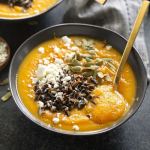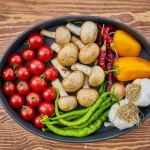- Like
- SHARE
- Digg
- Del
- Tumblr
- VKontakte
- Flattr
- Buffer
- Love This
- Save
- Odnoklassniki
- Meneame
- Blogger
- Amazon
- Yahoo Mail
- Gmail
- AOL
- Newsvine
- HackerNews
- Evernote
- MySpace
- Mail.ru
- Viadeo
- Line
- Comments
- Yummly
- SMS
- Viber
- Telegram
- JOIN
- Skype
- Facebook Messenger
- Kakao
- LiveJournal
- Yammer
- Edgar
- Fintel
- Mix
- Instapaper
- Copy Link
Inflammation has been a buzzword for quite some time now, and headlines link it to all sorts of health complications. But what is it? Where does it come from and how can we keep it at bay?
And if you regularly follow health news you most likely see stories about which foods may cause or reduce it. While there is no magical food to prevent chronic inflammation, understanding what it is, where it comes from, and how to adapt an anti-inflammatory lifestyle can safeguard you and your health against long-term inflammation.
But, don’t worry, not all inflammation is bad or harmful — some types can be beneficial. Here’s why.
Inflammation: What is it?
There are two types of inflammation: acute and chronic, both of which occur in our cells. Dr. Bill Cole, chiropractor and functional medicine and clinical nutrition expert explains it in simple terms: “Acute inflammation is the natural response of the immune system to protect and heal from injury or infection, where chronic inflammation is prolonged or long-term inflammation that can increase the risk of diseases like heart disease and autoimmune disease”. It becomes chronic when the underlying causes of inflammation are not properly addressed making you feel lousy, stiff, swollen, and tired.
So, what causes chronic inflammation? According to Cole, there are numerous things that cause damage to the cells leading to inflammation. “A diet in which there’s too much processed sugars and fats is a major driver of inflammation,” he says. While that may seem obvious, inflammation lurks in many other places. “Toxic chemicals in the air, water, food, beauty products, cleaning products, medications, and other areas are a major source of cell damage and subsequent inflammation,” he adds.
And it doesn’t stop there: Poor sleep and too much stress also impact the body negatively by creating long-term inflammation.
The good news is, inflammation can be lowered as you learn about where it comes from and how to lessen it.
It’s not all bad!
Unlike chronic inflammation, acute inflammation is actually beneficial. A sprained ankle, bee sting, and a fever are all examples of inflammation when it’s a good thing. The body is an amazing machine designed to respond to traumas or injuries in ways that encourage healing. Allison Barnes, Ph.D., the founder and CEO of R3bilt explains: “Not all inflammation is bad; in fact, most immune and healing processes in the entire body need a little amount of inflammation to work.”
For example, the soreness you feel post-leg day is your body doing its job to help heal torn muscle fibers and encourage repair. The redness you see around the cut you got while shaving is your body boosting blood flow to the area to speed up healing. So, although you may feel pain after a workout or your ankle swells up after a twist, these are the times where your body’s immune system is doing its job to stay healthy. It’s there to help speed healing and add protection to the body.
Where it hides
From low magnesium levels to even consuming certain condiments, chronic inflammation can rear its ugly head in ways you may not be aware of. “Some tricky places that can easily increase your inflammatory processes unnecessarily are in little things like your salad dressings,” warns Barnes. It all comes down to the type of oil and sugar content in your dressings.
“You want to stick to omega 3 oils and steer clear of omega 6. Olive or coconut oil are great choices,” Barnes says. Make sure to check the sugar content as well. “Sugar and omega 6 oils increase inflammation in the body very rapidly,” she adds. A great option is to use olive oil and vinegar or make your own dressing at home.
A magnesium deficiency is also another trigger. Barnes explains that people with high inflammatory markers often have low magnesium levels. “Over half of Americans do not get adequate levels of magnesium, so make sure to add a quality magnesium supplement or eat plenty of magnesium-rich food like spinach, almonds, and chia seeds,” says Barnes.
Elevated stress levels, overtraining, using beauty products that aren’t organic can also be triggers. Many household cleaning products are loaded with chemicals that can trigger an inflammatory immune response.
Eating clean, exercising responsibly, finding ways to reduce stress, and going organic with beauty and home products will help lower any chronic inflammation and bring your body back into a healthy balance.
Foods that cause inflammation
The foods (and drinks) you consume regularly will either feed the fire or help fight it off; and although you don’t have to give up your cheat meal, removing foods that are highly processed, high in refined sugars, have bad fats, are fried, contain MSG, and are overall heavily processed, is a great start to putting out the flame.
Many foods today are filled with unnecessary ingredients such as food coloring and binders that steadily increase the body’s inflammatory response. Granted, alcohol isn’t a food, but, when consumed heavily it produces a potentially hazardous response and may be better saved for a cheat meal or in moderation. Whatever you fuel your body the most with will play a big role in how you feel and look.
How to reduce chronic inflammation
Although there’s no miracle food out there that will heal chronic inflammation, living an anti-inflammatory lifestyle along with eating clean will set you on the right path.
In Latin, inflammation means to set on fire, and in order to put the fire out, eliminating the offender(s) is key. “The first thing that’s necessary to reduce or reverse inflammation is to identify and remove the underlying root causes,” Cole says. To eliminate it, we need to stop throwing gas on the fire.
And although our bodies are designed to heal, it’s necessary to create an environment in the body that’s conducive to healing. As Cole explains, “That’s an anti-inflammatory cellular healing environment that’s best fostered by eating a mostly organic whole food diet, getting proper rest, sleep, and exercise, as well as finding ways to alleviate stress.”
Remove and replace: Swap inflammatory foods such as highly processed meats and soda for fresh fish, fruits, veggies, nuts, turmeric, ginger, and olive oil, while adding stress-relieving activities to your life that you enjoy like hiking, exercise, reading, breath work, being present in nature. Anything that can relieve stress — do it!
Keep in mind, just like achieving a fitness goal, there isn’t one food or one activity that will bring you to your destination. The same goes with creating an anti-inflammatory body; it takes a lifestyle change; good food, solid sleep, using clean products, and finding ways to alleviate stress.


